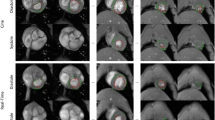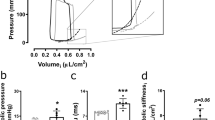Abstract
Since small-animal MRI generally requires anesthesia, the effect of the anesthetic regimen on the explored organ(s) has to be taken into account for study interpretation. In this work, we assess the influence of ketamine/xylazine and isoflurane anesthesia on left-ventricular (LV) function in the mouse in vivo by cine-MRI. Three groups of animals were anesthetized with ketamine/xylazine (n = 13) and two different concentrations of isoflurane (1.25%, n = 12 and 2.00%, n = 12) delivered in O2/N2O mix. Long- and short-axis cine-MRI was performed to measure end-diastolic volume, stroke volume, ejection fraction and LV wall thickness. Ketamine/xylazine significantly reduced heart rate, cardiac output and wall thickness, but increased stroke volume and end-diastolic volume compared with both isoflurane groups. No differences across all groups were observed in ejection fraction or systolic wall thickening. Breath rate under isoflurane was significantly lower and concentration dependent, whereas heart function was independent of concentration in all measured parameters. These findings are in agreement with echocardiography and catheterization studies. Isoflurane is advantageous for MR studies because it better maintains cardiac function. Taking into account previously obtained myocardial perfusion measurements, isoflurane concentration should, however, be maintained at the minimum required for a stable sleep even if cardiac function is unaffected by higher isoflurane concentrations.
Similar content being viewed by others
References
Chaves AA, Weinstein DM, Bauer JA (2001) Non-invasive echocardiographic studies in mice: influence of anesthetic regimen. Life Sci 69(2):213–222
Roth D, Swaney J, Dalton N, Gilpin E, Ross JJ (2002) Impact of anesthesia on cardiac function during echocardiography in mice. Am J Physiol Heart Circ Physiol 282(6):H2134–H2140
Yang XP, Liu YH, Rhaleb NE, Kurihara N, Kim HE, Carretero OA (1999) Echocardiographic assessment of cardiac function in conscious and anesthetized mice. Am J Physiol 277(5 Pt. 2):H1967–H1974
Hart CY, Burnett JC, Jr., Redfield MM (2001) Effects of avertin versus xylazine-ketamine anesthesia on cardiac function in normal mice. Am J Physiol Heart Circ Physiol 281(5):H1938–H1945
Tan TP, Gao XM, Krawczyszyn M, Feng X, Kiriazis H, Dart AM, Du XJ (2003) Assessment of cardiac function by echocardiography in conscious and anesthetized mice: importance of the autonomic nervous system and disease state. J Cardiovasc Pharmacol 42(2):182–190
Barbee R, Perry B, Re R, Murgo J (1992) Microsphere and dilution techniques for the determination of blood flows and volumes in conscious mice. Am J Physiol 263(3 Pt. 2):R728–R733
Janssen BJ, De Celle T, Debets JJ, Brouns AE, Callahan MF, Smith TL (2004) Effects of anesthetics on systemic hemodynamics in mice. Am J Physiol Heart Circ Physiol 287(4):H1618–H1624
Zuurbier CJ, Emons VM, Ince C (2002) Hemodynamics of anesthetized ventilated mouse models: aspects of anesthetics, fluid support, and strain. Am J Physiol Heart Circ Physiol 282(6):H2099–H2105
Groeben H, Meier S, Tankersley CG, Mitzner W, Brown RH (2003) Heritable differences in respiratory drive and breathing pattern in mice during anaesthesia and emergence. Br J Anaesth 91(4):541–545
Ruff J, Wiesmann F, Hiller K-H, Neubauer S, Rommel E, Haase A (1998) Influence of isoflurane anesthesia on contractility of mouse heart in vivo. A NMR imaging study. MAGMA 6 (Suppl.) 1:169
Crowley JJ, Huang CL, Gates AR, Basu A, Shapiro LM, Carpenter TA, Hall LD (1997) A quantitative description of dynamic left ventricular geometry in anaesthetized rats using magnetic resonance imaging. Exp Physiol 82(5):887–904
Schneider JE, Cassidy PJ, Lygate C, Tyler DJ, Wiesmann F, Grieve SM, Hulbert K, Clarke K, Neubauer S (2003) Fast, high-resolution in vivo cine magnetic resonance imaging in normal and failing mouse hearts on a vertical 11.7 T system. J Magn Reson Imaging 18(6):691–701
Kober F, Iltis I, Cozzone PJ, Bernard M (2004) Myocardial blood flow in mice using high-resolution spin-labeling perfusion MRI: Influence of ketamine/xylazine and isoflurane anesthesia. Magn Reson Med (in press)
Author information
Authors and Affiliations
Corresponding author
Rights and permissions
About this article
Cite this article
Kober, F., Iltis, I., Cozzone, P. et al. Cine-MRI assessment of cardiac function in mice anesthetized with ketamine/xylazine and isoflurane. MAGMA 17, 157–161 (2004). https://doi.org/10.1007/s10334-004-0086-0
Received:
Revised:
Accepted:
Published:
Issue Date:
DOI: https://doi.org/10.1007/s10334-004-0086-0




